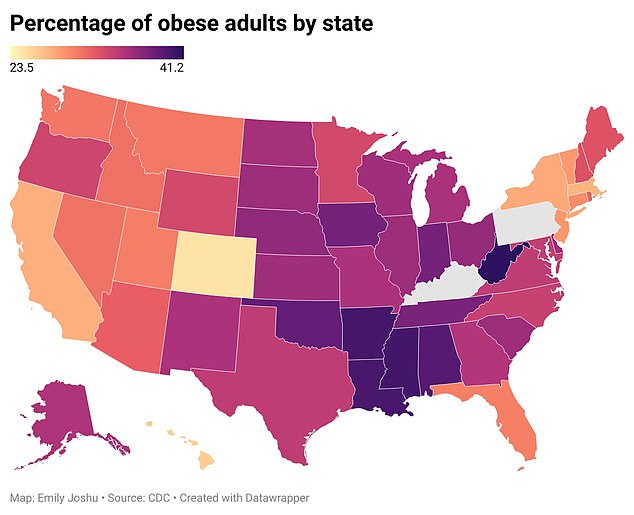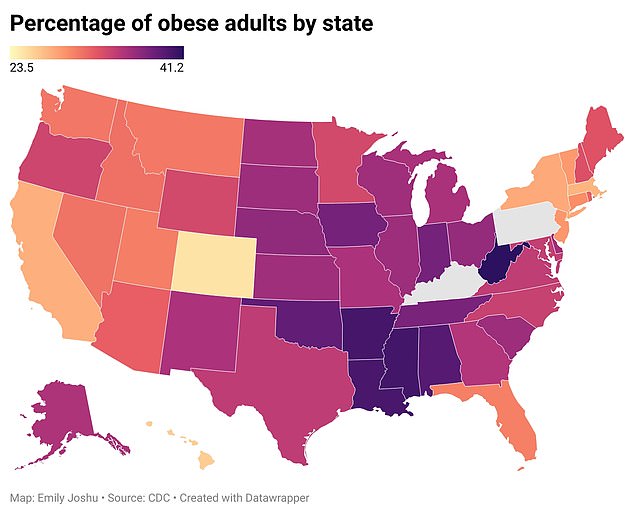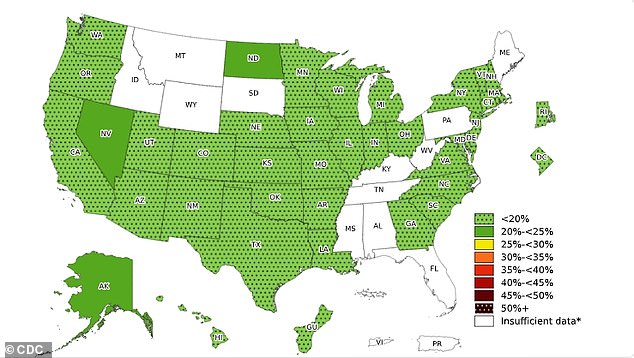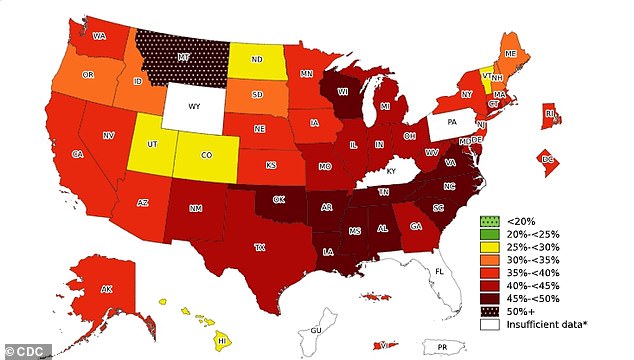According to the CDC, America is now fatter than ever before, with obesity rates on the rise again. But how heavy is YOUR state?





Americans are fatter than ever, new data from the CDC shows.
Before 2013, no state had an adult obesity rate of 35 percent or higher, but by 2023, 23 states will reach that alarming threshold.
In total, one in five American adults is obese, with rates highest in the Midwest and the South.
A record four states — West Virginia, Mississippi, Arkansas and Louisiana — had the highest rates of 40 percent in 2023, one more state than the previous year.
The map below shows data for 2023

Overall, one in five American adults is obese, with the Midwest and the South reporting the highest rates
In 23 states, obesity rates were above 35 percent, up four from the previous year.
While Washington DC and Colorado had the lowest rates, no state nationwide had fewer than one in five adults obese.
Dr. Karen Hacker, director of the CDC’s National Center for Chronic Disease Prevention and Health Promotion, said, “These new data underscore the need for prevention and treatment options for obesity. These begin with creating healthier communities where people of all ages have safe places to exercise and where health care and healthy food options are accessible and affordable for all.”
‘Preventing obesity at a young age is of great importance, because we know that children with obesity often become adults with obesity.’

The U.S. obesity rate has risen compared to a decade ago, when no state had an obesity rate above 35 percent. The CDC says it is an “urgent priority” to address the country’s growing waistline
The new data comes from the CDC’s Behavioral Risk Factor Surveillance System, which surveys 400,000 adults in all 50 states, DC and three territories.
According to the CDC, obesity is a body mass index (BMI) of at least 30.
West Virginia, which has consistently ranked in the top five for the past decade, had the highest obesity rate at 41.2 percent, the same rate as last year.
Experts warn that the Mountain State’s high ranking could be due to a widespread lack of exercise and healthy eating.
For example, CDC data shows that nearly one in three West Virginians do not participate in any form of physical activity or sports. Only Mississippi and Arkansas score higher.
According to West Virginia University, the state has the highest risk of food insecurity in the country.
This can lead to residents becoming dependent on unhealthy, cheap options such as fast food, skipping meals and overeating when food becomes available again.
The state’s obesity crisis may also be fueling a number of other conditions, including the state’s high rates of diabetes, high cholesterol and cancer.
Mississippi, Arkansas and Louisiana also broke the 40 percent barrier. Although Louisiana passed the barrier last year, Mississippi and Arkansas’ rates increased last year.
Mississippi saw a slight increase from 39.5 percent to 40.1 percent. Meanwhile, Arkansas didn’t even make the top 10 worst states last year, falling to the third worst spot.
Oklahoma, which ranked third worst last year, bucks this trend, dropping from 40 percent to 38 percent.

The CDC chart above shows obesity rates for Asian Americans, who were the group least likely to be obese

This chart from the CDC shows obesity rates for non-Hispanic black Americans, the group at highest risk for obesity
Washington DC and Colorado had the lowest obesity rates, at 23.5 percent and 25 percent, respectively.
While one in four adults in these regions is still considered obese, Colorado has seen a slight decrease in obesity rates compared to last year.
In 2022, Colorado recorded an obesity rate of 25 percent. In DC, there was no change from the previous year.
According to CDC data, Colorado has the highest level of physical activity, with one in six adults reporting no exercise at all.
Additionally, a study in the International Journal of Obesity found that people who live at high altitudes, such as in Colorado, are up to five times less likely to be obese. The researchers suggested that this could be because low oxygen levels at high altitudes can activate the vagus nerve, which is responsible for appetite control.
As for DC, this low percentage may be due to high physical activity rates. For example, one study found that DC had the most gyms in the country, with 20 per 100,000 residents.
Additionally, a 2024 report from the U.S. Department of Agriculture found that DC had the third lowest rate of food insecurity, just behind North Dakota and New Hampshire.
Asian adults were the only racial or ethnic group where no state had an obesity rate above 35 percent.
Dr. Ruth Petersen, director of the CDC’s Division of Nutrition, Physical Activity, and Obesity, said, “Obesity is a complex disease. There is a common misconception that obesity is the result of a lack of willpower and a failure of individuals to eat well and exercise.”
‘There are many factors that contribute to obesity, such as genes, certain medications, poor sleep, gut microbiome, stress, access to affordable food, safe places to exercise, and access to health care.’
“Understanding these factors can help us identify potential prevention and treatment strategies.”




